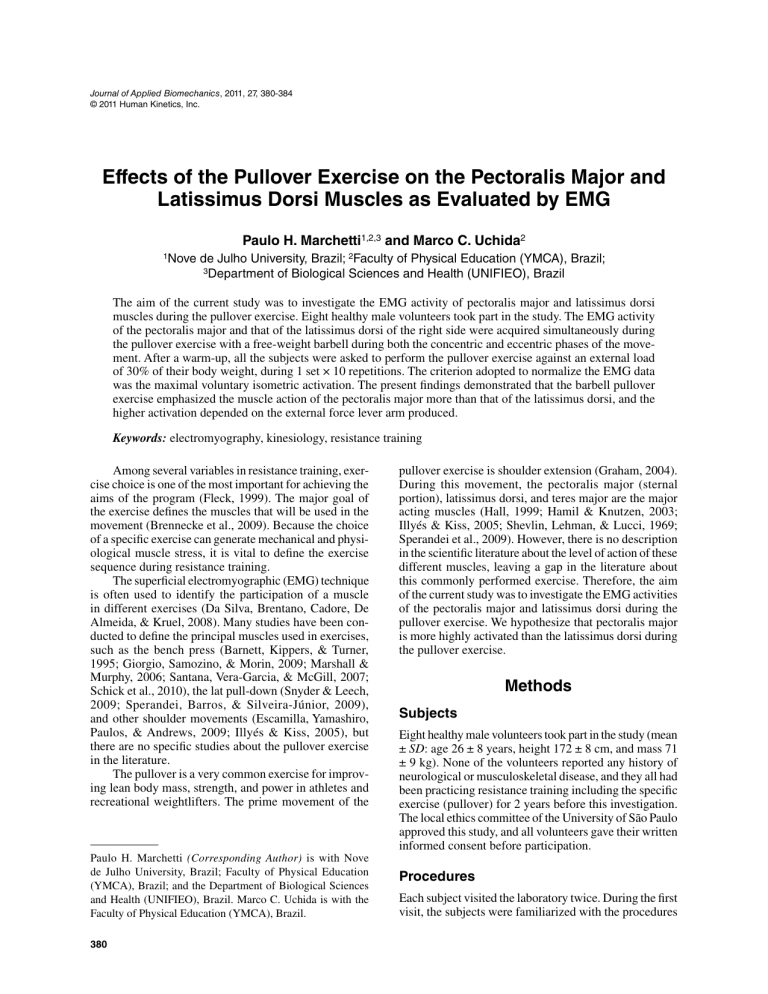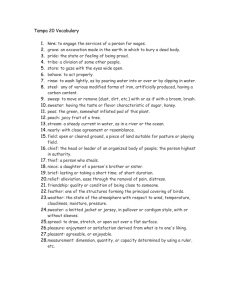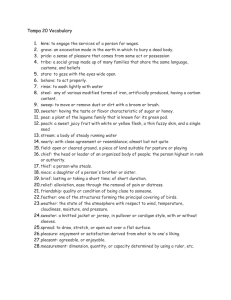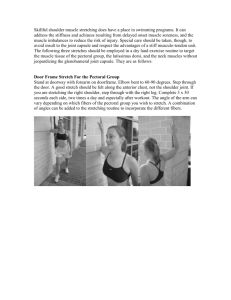
Journal of Applied Biomechanics, 2011, 27, 380-384 © 2011 Human Kinetics, Inc. Effects of the Pullover Exercise on the Pectoralis Major and Latissimus Dorsi Muscles as Evaluated by EMG Paulo H. Marchetti1,2,3 and Marco C. Uchida2 1Nove de Julho University, Brazil; 2Faculty of Physical Education (YMCA), Brazil; 3Department of Biological Sciences and Health (UNIFIEO), Brazil The aim of the current study was to investigate the EMG activity of pectoralis major and latissimus dorsi muscles during the pullover exercise. Eight healthy male volunteers took part in the study. The EMG activity of the pectoralis major and that of the latissimus dorsi of the right side were acquired simultaneously during the pullover exercise with a free-weight barbell during both the concentric and eccentric phases of the movement. After a warm-up, all the subjects were asked to perform the pullover exercise against an external load of 30% of their body weight, during 1 set × 10 repetitions. The criterion adopted to normalize the EMG data was the maximal voluntary isometric activation. The present findings demonstrated that the barbell pullover exercise emphasized the muscle action of the pectoralis major more than that of the latissimus dorsi, and the higher activation depended on the external force lever arm produced. Keywords: electromyography, kinesiology, resistance training Among several variables in resistance training, exercise choice is one of the most important for achieving the aims of the program (Fleck, 1999). The major goal of the exercise defines the muscles that will be used in the movement (Brennecke et al., 2009). Because the choice of a specific exercise can generate mechanical and physiological muscle stress, it is vital to define the exercise sequence during resistance training. The superficial electromyographic (EMG) technique is often used to identify the participation of a muscle in different exercises (Da Silva, Brentano, Cadore, De Almeida, & Kruel, 2008). Many studies have been conducted to define the principal muscles used in exercises, such as the bench press (Barnett, Kippers, & Turner, 1995; Giorgio, Samozino, & Morin, 2009; Marshall & Murphy, 2006; Santana, Vera-Garcia, & McGill, 2007; Schick et al., 2010), the lat pull-down (Snyder & Leech, 2009; Sperandei, Barros, & Silveira-Júnior, 2009), and other shoulder movements (Escamilla, Yamashiro, Paulos, & Andrews, 2009; Illyés & Kiss, 2005), but there are no specific studies about the pullover exercise in the literature. The pullover is a very common exercise for improving lean body mass, strength, and power in athletes and recreational weightlifters. The prime movement of the Paulo H. Marchetti (Corresponding Author) is with Nove de Julho University, Brazil; Faculty of Physical Education (YMCA), Brazil; and the Department of Biological Sciences and Health (UNIFIEO), Brazil. Marco C. Uchida is with the Faculty of Physical Education (YMCA), Brazil. 380 pullover exercise is shoulder extension (Graham, 2004). During this movement, the pectoralis major (sternal portion), latissimus dorsi, and teres major are the major acting muscles (Hall, 1999; Hamil & Knutzen, 2003; Illyés & Kiss, 2005; Shevlin, Lehman, & Lucci, 1969; Sperandei et al., 2009). However, there is no description in the scientific literature about the level of action of these different muscles, leaving a gap in the literature about this commonly performed exercise. Therefore, the aim of the current study was to investigate the EMG activities of the pectoralis major and latissimus dorsi during the pullover exercise. We hypothesize that pectoralis major is more highly activated than the latissimus dorsi during the pullover exercise. Methods Subjects Eight healthy male volunteers took part in the study (mean ± SD: age 26 ± 8 years, height 172 ± 8 cm, and mass 71 ± 9 kg). None of the volunteers reported any history of neurological or musculoskeletal disease, and they all had been practicing resistance training including the specific exercise (pullover) for 2 years before this investigation. The local ethics committee of the University of São Paulo approved this study, and all volunteers gave their written informed consent before participation. Procedures Each subject visited the laboratory twice. During the first visit, the subjects were familiarized with the procedures Downloaded by Purdue Univ on 09/16/16, Volume 27, Article Number 4 Pullover Exercise as Evaluated by EMG 381 used in the main session. Subjects were assessed at the same time of day (between 2:00 and 3:00 pm), and they were instructed to refrain from any strenuous activities in the 72 hr before the procedure. One week after the first visit, the subjects attended the main session, which began with a warm-up that consisted of performing the pullover exercise against an external load of 15% of their body weight during 2 sets × 10 repetitions, with 1 min between sets. Next, all the subjects performed the pullover exercise against an external load of 30% of their body weight, during 1 set × 10 repetitions (Folland, Mc Cauley, & Williams, 2008; Thompson et al., 2010). The pullover exercise was executed while maintaining contact of the head, back, and buttocks with the bench. The arms were kept extended at the between-hands distance equal to the shoulder joint and with the feet on the floor (Graham, 2004). The excursion of the movement was defined by the alignment of the barbell with the line of the shoulder (i.e., vertical alignment, referred to as 0°) and the maximal shoulder extension (maximal degree) (Figures 1 and 2). To control the cadence between subjects, a metronome with 2 s for each phase was used (concentric muscular action [CMA] and eccentric muscular action [EMA]), and the shoulder angle was controlled by an electrogoniometer (NorAngle, Noraxon, USA) attached between the right arm and right side of the trunk. The shoulder angle was offset in the alignment of the barbell with the line of the shoulder (i.e., vertical alignment). The EMG signals were recorded with an 8-channel telemetric EMG system (Telemyo 900, Noraxon MyoResearch, USA) and a preamplifier (gain 1,000×), common mode rejection > 85 dB. The participants’ skin was prepared before placement of the EMG electrodes. Hair at the site of electrode placement was shaved and the skin cleaned with alcohol. Bipolar passive disposable dual Ag/AgCl snap electrodes with a 1-cm diameter for each circular conductive area and 2-cm center-to-center spacing were placed over the longitudinal axes of the pectoralis major (sternal portion) and latissimus dorsi (ascendant fibers) in the direction of the muscle fiber. The positions of the electrodes were marked on the skin by small ink tattoos, which ensured the same electrode position in each test over the 1-week experimental protocol. The EMG activities of the pectoralis major and latissimus dorsi of the right side were acquired simultaneously during the pullover exercise with a regular barbell bar (1.2 m). All measurements were taken on the right side of the participants’ bodies and reference electrodes were placed over the bone on the clavicle. The EMG signals were acquired with a sampling rate of 1024 Hz, and data acquisition was managed using MyoResearch software (Noraxon MyoResearch, USA). Surface EMG was used to measure muscle activation during both the CMA and EMA of the movement. The criterion adopted to normalize the EMG data was the maximal voluntary isometric activation (MVIA). Three MVIAs were performed against a manual resistance produced by a research assistant, in the following two positions: (1) the pectoralis major—supine position with the right shoulder horizontally abducted at 90° and (2) the latissimus dorsi—supine position with the right shoulder aligned with the trunk and abducted at 15°. The subjects were asked to perform three MVIAs for 3 s, and the EMG data of both muscles were acquired. For the data, we calculated the root mean square (RMS) (1-s moving window) of the EMG amplitude, and the peak of the RMS EMG value of the three MVIAs was used for normalization. Data Analysis First, the shoulder angle data were low-pass filtered with 1 Hz using a fourth-order Butterworth filter. The minimal angle was used to define the beginning and ending of the EMG data; we removed the first and last repetitions from this data to avoid body adjustments and fatigue effects. The digitized EMG data were first band-pass filtered at 20–500 Hz using a fourth-order Butterworth filter with a zero lag. The amplitude of the signals was expressed as RMS (1-s moving window) and normalized by MVIA. The RMS EMG then were integrated (IEMG) and normalized on the temporal base (% movement cycle). All data were analyzed using a customized program written in Matlab (Mathworks Inc., USA). The intraclass correlation coefficients were r = .83 and r = .96 for pectoralis major and latissimus dorsi, respectively. Statistical Analyses The normality and homogeneity of the data variances were confirmed by the Kolmogorov–Smirnov and the Lilliefors tests, respectively. We performed a comparison of the muscle activation of the pectoralis major and latissimus dorsi during the pullover exercise using a paired t test. An alpha of 0.01 was used for all statistical tests performed using the SPSS version 18.0. Results Figure 1 — Phases of the pullover exercise. Figure 1 shows the phases of the pullover exercise. Figure 2 shows the RMS EMG of the pectoralis major and latissimus dorsi during the pullover exercise cycle. The IEMG of the pectoralis major was significantly larger than that of the latissimus dorsi during the pullover exercise, t(7) = 10.28; p < .001 (Figure 3). Downloaded by Purdue Univ on 09/16/16, Volume 27, Article Number 4 382 Marchetti and Uchida Figure 2 — Mean ± SD of the RMS EMG of the pectoralis major and latissimus dorsi during the pullover cycle. Figure 3 — Mean ± SD of the IEMG of the pectoralis major and latissimus dorsi (*p < .001). Discussion The present study investigated the EMG activities of the pectoralis major and latissimus dorsi during the pullover exercise. Mechanically, the pullover exercise begins with arms positioned perpendicular to the trunk and vertically aligned with the shoulder joint (Graham, 2004). In this position, the lever arm is minimal because the line of action force (external) is aligned with both the elbow and the shoulder joints. In addition, the muscles (internal forces) stabilize the joints, as shown in Figures 1 and 2 (beginning of the movement cycle, 0°). The first part of the movement is downward (shoulder flexion, EMA) until the upper arms are parallel to the trunk. During the EMA, the lever arm of the external force increases for both the elbow and shoulder joints, reaching the maximal external torque at the end of this phase at approximately 100°. After that, the second part of the movement is upward (shoulder extension, CMA), with the arms returning to 0°. During the CMA, the lever arm of the external force decreases for both the elbow and shoulder joints, reaching the minimal external torque at the end of this phase. There is little scientific information concerning the principal muscles involved in the pullover exercise. However, muscle activity patterns and coordination have been investigated by EMG to determine the motor control during several exercises (Barnett et al., 1995; Da Silva et al., 2008; Dionisio, Almeida, Duarte, & Hirata, 2008; Earl, Schmitz, & Arnold, 2001; Escamilla et al., 2009; Giorgio et al., 2009; Illyés & Kiss, 2005; Liebensteiner, 2008; Marshall & Murphy, 2006; Santana et al., 2007; Schick et al., 2010; Snyder & Leech, 2009; Sperandei et al., 2009). Downloaded by Purdue Univ on 09/16/16, Volume 27, Article Number 4 Pullover Exercise as Evaluated by EMG 383 We hypothesized that the pectoralis major is more highly activated than the latissimus dorsi during the pullover exercise. In fact, according to our results, the pectoralis major presented a higher activation than the latissimus dorsi during all movement cycles, and the IEMG of the latissimus dorsi was approximately 10% of the IEMG of the pectoralis major (Figure 3). We observed higher muscle activation during the concentric phase than the eccentric phase, which was reported in other studies (Griffin, Tooms, Vander Zwaag, Bertorini, & O’Toole, 1993; Kellis & Baltazopoulos, 1995, 1998; Pincivero, Coelho, & Campy, 2008; Sperandei et al., 2009). In the pullover exercise, we found that the highest level of muscle action is related to the greatest lever arm lever during the ascendant phase (Figure 2). We recognize that this study has limitations, such as small sample size and the load adjustment using a percentage of the body weight. However, the pattern of EMG data during all cycles was similar among the subjects, who all reached a fatigue condition by the end of the set of 10 repetitions (i.e., previously defined by the pilot study wherein 30% body weight ∼ 10 repetitions maximum). In summary, the pullover is a very common exercise for improving lean body mass, strength, and power in athletes and recreational weightlifters, and its principal movement is shoulder extension. The present findings demonstrate that the barbell pullover exercise could emphasize the muscle action of the pectoralis major more than the latissimus dorsi, and the higher activation depends on the external force lever arm produced. Therefore, during resistance training programs, coaches, athletes, and recreational weightlifters need to fit the pullover exercise into the correct training session with the aim of developing the pectoralis major. Most exercises for pectoralis major training are restricted to horizontal adduction at the shoulder (CMA); examples are the bench press, fly, and crossover. Thus, an alternative movement variation could be the pullover exercise, which is characterized by shoulder extension. Acknowledgments The authors acknowledge Marcos Duarte, Biomedical Engineering, Federal University of ABC, Brazil, and Luis Felipe Milano Teixeira, Department of Biological Sciences and Health, Osasco, Brazil, and Veris Faculty, Sorocaba, Brazil. References Barnett, C., Kippers, V., & Turner, P. (1995). Effects of variation of the bench press exercise on the EMG activity of five shoulder muscles. Journal of Strength and Conditioning Research, 9(4), 222–227. Brennecke, A., Guimarães, T.M., Leone, R., Cadarci, M., Mochizuki, L., Simão, R., et al. (2009). Neuromuscular activity during bench press exercise performed with and without the preexhaustion method. Journal of Strength and Conditioning Research, 23(7), 1933–1940. Da Silva, E.M., Brentano, M.A., Cadore, E.L., De Almeida, A.P.V., & Kruel, L.F.M. (2008). Analysis of muscle activation during different leg press exercises at submaximum effort levels. Journal of Strength and Conditioning Research, 22, 1059–1065. Dionisio, V.C., Almeida, G.L., Duarte, M., & Hirata, R.P. (2008). Kinematic, kinetic and EMG patterns during downward squatting. Journal of Electromyography and Kinesiology, 18, 134–143. Earl, J.E., Schmitz, R.J., & Arnold, B.L. (2001). Activation of the VMO and VL during dynamic mini-squat exercises with and without isometric hip adduction. Journal of Electromyography and Kinesiology, 11, 381–386. Escamilla, R.F., Yamashiro, K., Paulos, L., & Andrews, J.R. (2009). Shoulder muscle activity and function in common shoulder rehabilitation exercises. Sports Medicine (Auckland, N.Z.), 39(8), 663–685. Fleck, S.J. (1999). Periodized strength training: A critical review. Journal of Strength and Conditioning Research, 13(1), 82–89. Folland, J.P., Mc Cauley, T.M., & Williams, A.G. (2008). Allometric scaling of strength measurements to body size. European Journal of Applied Physiology, 102(6), 739–745. Giorgio, P., Samozino, P., & Morin, J.B. (2009). Multigrip flexible device: Electromyographical analysis and comparison with the bench press exercise. Journal of Strength and Conditioning Research, 23(2), 652–659. Graham, J.F. (2004). Dumbbell pullover. Strength and Conditioning Journal, 26(2), 48–49. Griffin, J.W., Tooms, R.E., Vander Zwaag, R., Bertorini, T.E., & O’Toole, M.L. (1993). Eccentric muscle performance of elbow and knee muscle groups in untrained men and women. Medicine and Science in Sports and Exercise, 25, 936–944. Hall, S.J. (1999). Basic Biomechanics. New York: McGrawHill Companies. Hamil, J., & Knutzen, K.M. (2003). Biomechanical basis of human movement. Philadelphia: Lippincott Williams & Wilkins. Illyés, Á., & Kiss, R.M. (2005). Shoulder muscle activity during pushing, pulling, elevation and overhead throw. Journal of Electromyography and Kinesiology, 15, 282–289. Kellis, E., & Baltazopoulos, V. (1995). Isokinetic eccentric exercise. Sports Medicine (Auckland, N.Z.), 19, 202–222. Kellis, E., & Baltazopoulos, V. (1998). Muscle activation differences between eccentric and concentric isokinetic exercise. Medicine and Science in Sports and Exercise, 30, 1616–1623. Liebensteiner, M.C. (2008). Frontal plane leg alignment and muscular activity during maximum eccentric contractions in individuals with and without patellofemoral pain syndrome. The Knee, 15, 180–186. Marshall, P.W.M., & Murphy, B.A. (2006). Increased deltoid and abdominal muscle activity during swiss ball bench press. Journal of Strength and Conditioning Research, 20(4), 745–750. Pincivero, D.M., Coelho, A.J., & Campy, R.M. (2008). Contraction mode shift in quadriceps femoris muscle activation during dynamic knee extensor exercise with increasing loads. Journal of Biomechanics, 41, 3127–3132. Santana, J.C., Vera-Garcia, F.J., & McGill, S.M. (2007). A kinetic and alectromyography comparision of the standing cable press and bench press. Journal of Strength and Conditioning Research, 21(4), 1271–1279. 384 Marchetti and Uchida Downloaded by Purdue Univ on 09/16/16, Volume 27, Article Number 4 Schick, E.E., Coburn, J.W., Brown, L.E., Judelson, D.A., Khamaoui, A.V., Tran, T.T., et al. (2010). A comparision of muscle activation between a smith machine and free weight bench press. Journal of Strength and Conditioning Research, 24(3), 779–784. Shevlin, M.G., Lehman, J.F., & Lucci, J.A. (1969). Electromyographic study of the function of some muscles crossing the glenohumeral joint. Archives of Physical Medicine and Rehabilitation, 50, 264–270. Snyder, B.J., & Leech, J.R. (2009). Voluntary increase in latissimus dorsi muscle activity the lat pull-down following expert instruction. Journal of Strength and Conditioning Research, 23(8), 2204–2209. Sperandei, S., Barros, M.A.P., & Silveira-Júnior, P.C.S. (2009). Electromyographic analysis of three different types of lat pull-down. Journal of Strength and Conditioning Research, 23(7), 2033–2038. Thompson, B.J., Smith, D.B., Jacobson, B.H., Fiddler, R.E., Warren, A.J., Long, B.C., et al. (2010). The influence of ratio and allometric scaling procedures for normalizating upper body power output in division I collegiate football players. Journal of Strength and Conditioning Research, 24(9), 2269–2273.




